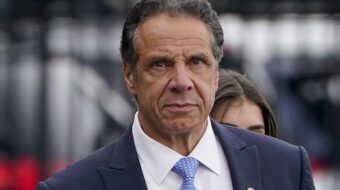Leaders of the Leadership Conference on Civil Rights (LCCR) and the Anti-Defamation League (ADL) held a June 16 conference call to release a new report called, “Confronting the New Faces of Hate Crimes in America.”
“Last week an 88-year-old white supremacist entered the Holocaust Museum in Washington D.C. and opened fire on the guard who let him in,” said Wade Henderson, president of LCCR. “Now is the time for Congress to act on hate crime legislation.”
“No civil right is more important than protecting individuals from acts of violence due to race, sex, gender, language or disability,” he added.
The report begins: “For many, the election of President Barack Obama appeared to close the book on a long history of inequality in America. But the spate of racially-motivated hate crimes and violence against minorities and immigrants that occurred before and after Election Day makes clear that a final victory over prejudice and racial hostility remains elusive. It is time for our nation to redouble its efforts to combat the commission of hate crimes in America.”
Henderson noted that President Obama has received more threats than any other president in recent history.
Acts of violence committed against individuals because of their race, religion, ethnicity, national origin, gender, gender identity, or sexual orientation remains a serious problem, says the report. Nearly 20 years after the 1990 enactment of the Hate Crime Statistics Act, the number of hate crimes reported has consistently ranged around 7,500 or more annually, which is about one crime every hour of every day.
The number of hate groups operating in the U.S. continued to rise in 2008 and has grown by 54 percent since 2000. Some extremist groups are exploiting the economic crisis, spreading propaganda that blames minorities and immigrants for the subprime mortgage meltdown.
The report highlights as a major concern the increasing number, in the past four years, of hate crimes committed against Hispanics and those perceived to be immigrants.
The number of hate crimes committed against individuals because of their sexual orientation has also increased to its highest level in five years.
Also on the call was Michael Lieberman, Washington counsel for the ADL and co-editor of the report. Saying that his group supports “comprehensive immigration reform,” Lieberman declared, “We need a civil and sane tone in this debate.”
The report cites various instances in 2008 where hate crimes involving acts of violence occurred.
For example in July 2008, in Shenandoah, Pa., Luis Ramirez, a 25-year-old Mexican and father of two, was reportedly beaten to death by four teenagers because of his Latino ethnicity.
On Election Night, two young men in Staten Island, N.Y., shortly after learning Obama won went on a joy ride to find African Americans to assault. The men drove to a predominantly African American community where they came upon a 17-year-old African American walking home. They got out of the car and beat the youth with a metal pipe and baton, injuring his head and legs. Both men went on to commit additional assaults culminating with crashing their car into a man whom they mistakenly believed to be African American, causing his body to shatter the windshield.
And in February of last year, 15-year-old Lawrence King, an openly gay student in Oxnard, Calif., was shot to death while sitting in a computer lab at his high school as fellow students watched in horror. The gunman was age 14 and investigators discovered a trove of white supremacist literature and drawings depicting a racist skinhead philosophy, according to the prosecution.
Many victims of hate crimes may be fearful of authorities and fail to report such incidents, the report points out. In many instances local authorities may not accurately classify violent acts as hate crimes, so they may not get reported to the federal government. Much of the report is based on an FBI data collection effort in 2007 — the most recent national information available.
Hate crimes directed at Hispanics correlate closely with the increasingly heated debate over comprehensive immigration reform and an escalation in the level of anti-immigrant vitriol on radio, television and the Internet. Groups opposing immigration reform such as the Federation for American Immigration Reform, the Center for Immigration Studies and NumbersUSA continue to flame the debate by invoking racist stereotypes and hate group bigotry, says the report.
The “virulently anti-immigrant rhetoric” of “these seemingly ‘legitimate’ advocates against illegal immigration … veers dangerously close to — and too often crosses the line beyond — civil discourse over contentious immigration policy issues,” the report says.
Media personalities such as CNN’s Lou Dobbs and Talk Show Network’s “The Savage Nation” host Michael Savage, who speak of immigrants as “invaders poisoning communities with disease and criminality,” create an atmosphere in which some people will act violently, targeting immigrants and Latinos.
The report says, “Fear and vilification of immigrants has combined with the worst economic downturn in decades and the election of the first African American president to cause a surge in activity of white supremacist groups.”
The number of hate groups operating in the U.S. increased more than 4 percent in 2008 and has grown by 54 percent since 2000, according to the Southern Poverty Law Center (SPLC).
Mark Potok, editor of the Intelligence Report published by the SPLC, is quoted in the new report as saying, “Barack Obama’s election has inflamed racist extremists who see it as another sign that their country is under siege by non-whites.” Potok continues, “The idea of a black man in the White House, combined with the deepening economic crisis and continuing high levels of Latino immigration, has given white supremacists a real platform on which to recruit.”
Such extremists are now taking advantage of the Internet using mainstream social networking sites as MySpace or Facebook to promote their bigoted ideologies to a potential audience of millions — including impressionable youth, the report says.
The report notes, “Eliminating the prejudice that underlies hate crimes requires that Americans develop respect for cultural differences and establish dialogue across racial, ethnic, cultural, and religious boundaries. Education, awareness, and acceptance of group differences are the cornerstones of a long-term solution to prejudice, discrimination, and bigotry. Hate crime laws and effective responses to hate violence by public officials and law enforcement authorities can play an essential role in deterring and preventing these crimes, creating a healthier and stronger society for all Americans.”
The report’s recommendations on addressing hate violence in the U.S. include the following:
– Setting the tone for a civil national discourse on comprehensive immigration reform where leaders from every sector — including government, media, business, labor, religion, and education — have an essential role in shaping attitudes in opposition to all forms of bigotry.
– Ensuring a strong law enforcement response that confronts violent hate crimes including the enactment of the Local Law Enforcement Hate Crimes Prevention Act, which will give local authorities important tools to combat such situations. The measure, once signed into law, would also amend the Hate Crimes Statistics Act of 1990 to mandate additional Justice Department hate crime data collection reporting requirements for bias-motivated violence directed at individuals on the basis of their gender and gender identity, and for crimes committed by and against juveniles.
– In order to complement tough laws and vigorous enforcement, education and training initiatives designed to reduce prejudice should be implemented. The Justice Department, the Department of Education and other involved federal agencies should institutionalize and coordinate their responses to hate crimes and federally fund programs for schools nationwide that include violence prevention initiatives.
“This report is just a snapshot of where we are today,” said Lieberman. “It is a warning to all of us and presents the human face and human cost of the many victims of hate crimes in the U.S.”
“More still needs to be done,” he said.
plozano @ pww.org









